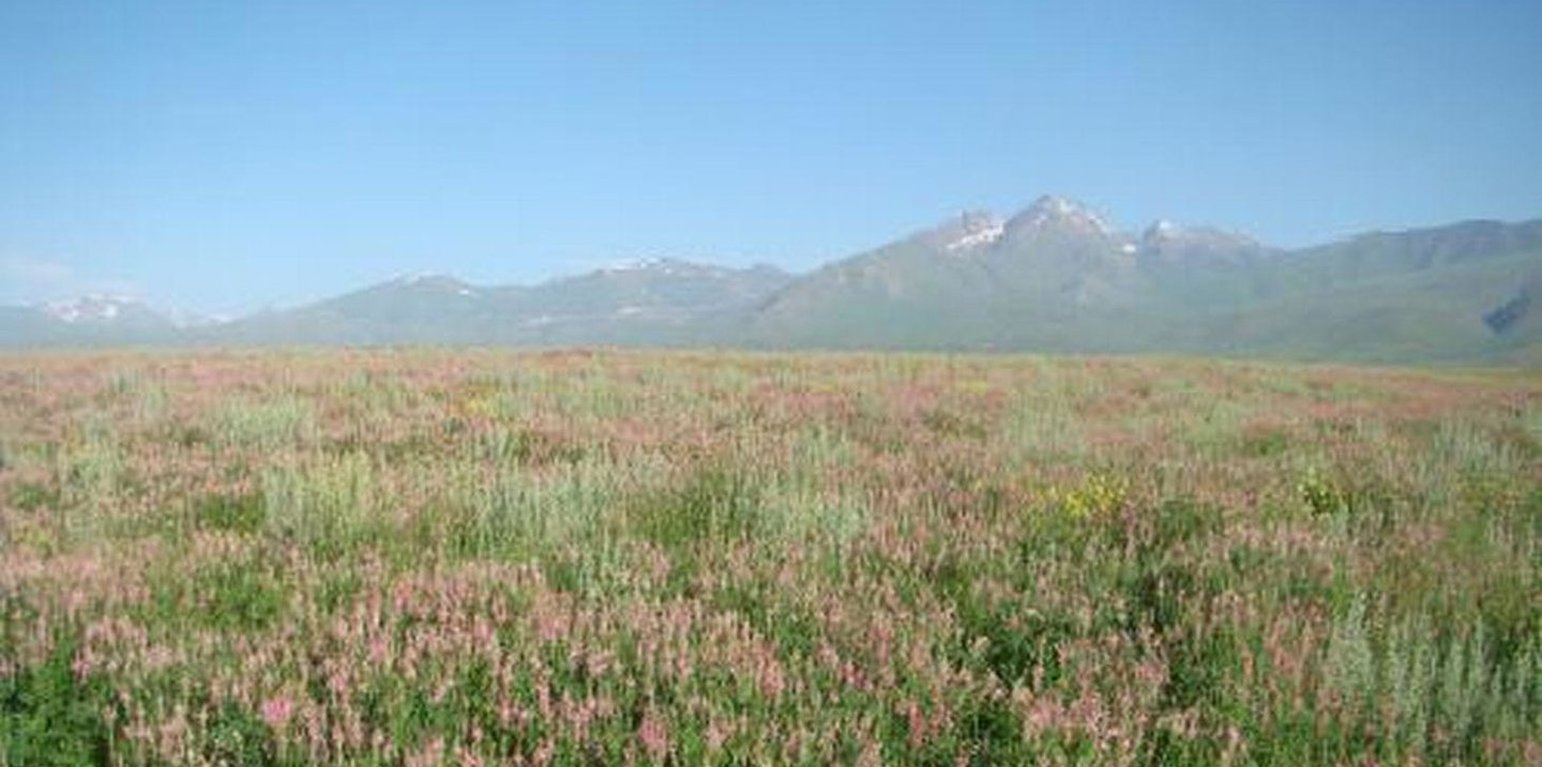



The Suusamyr Plain is located in the South-West of Chui Valley. Generally, this zone, located at 2000-3800 meters above sea level is used by farmers as summer pastures. Farmers are practicing agro-pastoralism by grazing animals and at the same time producing winter fodder for their livestock. They cultivate mainly barley and sometimes perennial grass.
The territory of the local administration of the Aiyl Okrug “Suusamyr” includes 6645 hectares of arable land. In 2009 about 2500 hectares were cultivated with cereals (including 1950 ha of barley) and 250 ha with sainfoin. As a result of the monoculture of cereals, weeds, pests, and insects accumulate on the fields and the soil fertility is declining. These are direct and indirect indicators of soil degradation.
The main cultivated perennial legume is sainfoin. However,farmers are short of sainfoin seeds. Most of them cultivate sainfoin for hay making and consider the seed production as non profitable.
Fallow is maintained free from weed during the vegetation season. As fallow is weed free and accumulates the soil moisture it has synergy effect to harvest high yield of barley grain. This fallow is kept during one vegetation season and applied by other farmers during next season. Crop rotation cycle is 5 years including 1 year-fallow period (1year-fallow period, 1year for barley planting and 3 years for sainfoin planting). Barley is planted into the fallow.
Sainfoin improves the soil structure as a result of high rizo-biomasses (237-333 kg/ha). Sainfoin is able to accumulate 194 -178 kg/ha of biological nitrogen providing sufficient nitrogen fertilization for two consecutive cropping seasons. Sainfoin can be cultivated at altitudes from 700 to 3400 m above sea level (G. Balian, 2004). Sainfoin is a high nectar producting crop, allowing farmers to produce 150 kg of honey from 1 hectare of sainfoin during a vegetation period. As the result of insect pollination, an increase in seed production of between 100 and 200 kg/ha has been observed.
Purpose of the Technology: Soil fertility conservation through crop rotation of barley with the perennial grass sainfoin (Onobrichis sativa).
Farmer Ibraimov Azimjan has 25 hectares of private land and rents other land from neighboring farmers. UNDP’s project procured seeds of sainfoin and covered expenditures for tillage and planting. The farmer’s responsibility is to distribute produced seeds among other farmers which are able to expand their areas under sainfoin cultivation. The farmers maintains crop rotation.
Fields are located in the foothills at an elevation of 2038-2200 m above sea level. Plowing is conducted along the slope. But planting is done across to the tilling direction, horizontally along the field (contour planting drilling). This technology increases vegetation cover and after harvesting stubbles remain
Agriculture in Suusamyr Valley is based on animal husbandry which is kept on pastures during three seasons (spring, summer and autumn). But farmers practice agro-pastorals. They have private arable land and produce cereals and forage crops. The Local Government “Suusamyr” has 6645 hectares of arable land including 561 hectares from the Distribution Found (state regulated land). Farmers are not subsidized by the Government.
The farmer Ibraimov Azimjan has 25 hectares of private land and rents other land from the neighboring farmers. In 2009 UNDP’s project procured basic seeds of sainfoin and covered the expenditures for tillage and planting. UNDP’s project organized several workshops for farmers on technology of cereals and forage crops cultivation. Project manager also had finance support in field inspection of sainfoin seed and barley.
Farmer’s responsibility is to distribute seed among other farmers which able to expand their areas under sainfoin. Farmer has resources to guard the field from grazing of animals during the vegetation period, harvest and transportation of seed. Azimjan also organized the seed cleaning and storage. Project’s management developed the rules on seed distributions and sale.
The farmer should produce sainfoin and barley in order to get benefit. Farmer’s responsibility is to distribute seed to other farmers which able to expand the area under sainfoin and barley. Name of sainfoin variety is “Belek”, barley variety is “Kylym”, they are developed in research centers of Kyrgyz Republic.
The population of the Aiyl Okrug “Suusamyr” is 6400. The Local Government has no human resources for field activities. There are six villages at the territory of this Local Government. All fields and villages are connected by dirt roads. The electricity is supplied on regularly basis. People have drinking water supplies.
Farmer’s fields are located at foothills of 2038-2200 m above sea level. The type of land use is rainfed. Some irrigated channels which were developed in Soviet time are destroyed now. The fields are infested mainly with wild Oat, Couch-grass, spp. pigweed, wormwood and others.
The farmers cultivate cereals as monoculture. Some of them plant the sainfoin. Additionally, farmers cultivate potato on a total area of 180-200 hectares. The varieties are from local breeders (Nevsky, Cardinal) and introduced varieties from seed Firm “Agrico” and “NZPC” (Picasso, Sante and Mondial).
The main type of soil is chestnut (light chestnut soil and dark chestnut soil). The potential fertility of these soils is high but due to the lack of crop rotation, plant protection activities, fertilizer application, soil degradation is going on. There are no soil maps in the office of local administration except for those which were developed during the Soviet time.
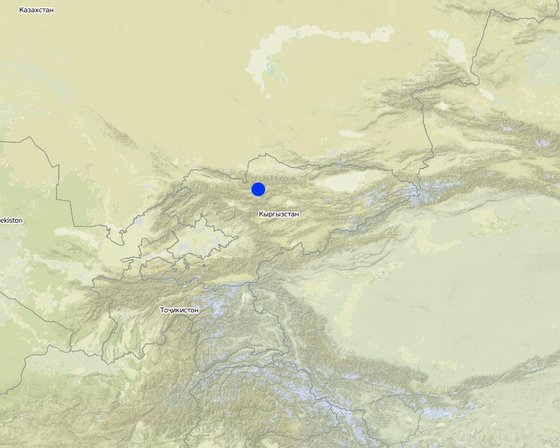
ສະຖານທີ່: Jayl district, Kyrgyz Republic, Chui oblast, ກີກັດຕັນ
ຈໍານວນ ພື້ນທີ່ ທີ່ໃຊ້ ເຕັກໂນໂລຢີ ທີ່ໄດ້ວິເຄາະ:
ການແຜ່ກະຈາຍຂອງເຕັກໂນໂລຢີ: ແຜ່ຂະຫຍາຍຢ່າງໄວວາໃນພື້ນທີ່ (approx. 0.1-1 ກມ 2)
ວັນທີຂອງການປະຕິບັດ: ຕໍ່າກວ່າ 10 ປີ ຜ່ານມາ (ມາເຖິງປະຈຸບັນ)
ປະເພດຂອງການນໍາສະເໜີ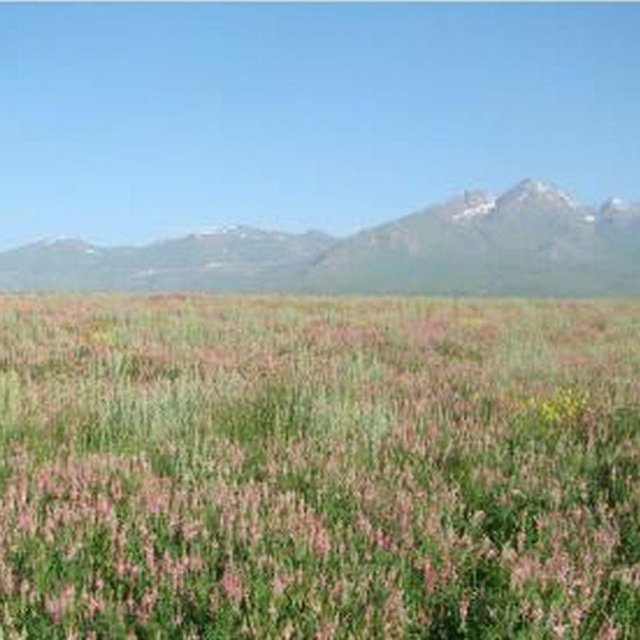
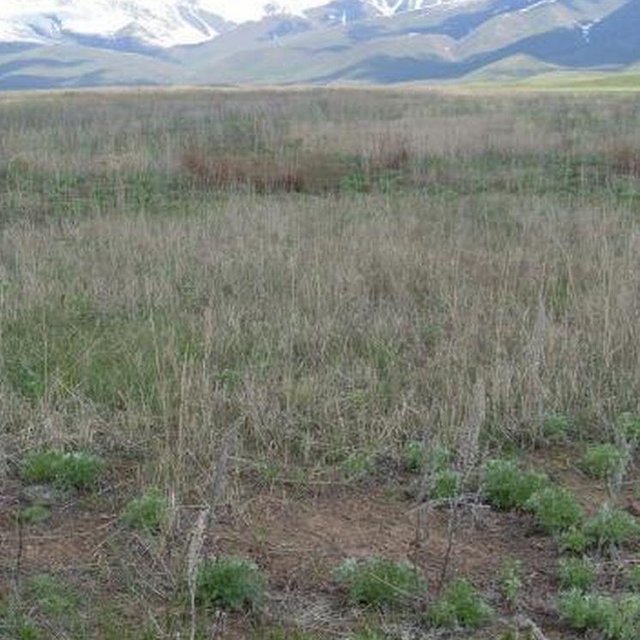






ຂໍກຳນົດທາງເທັກນິກ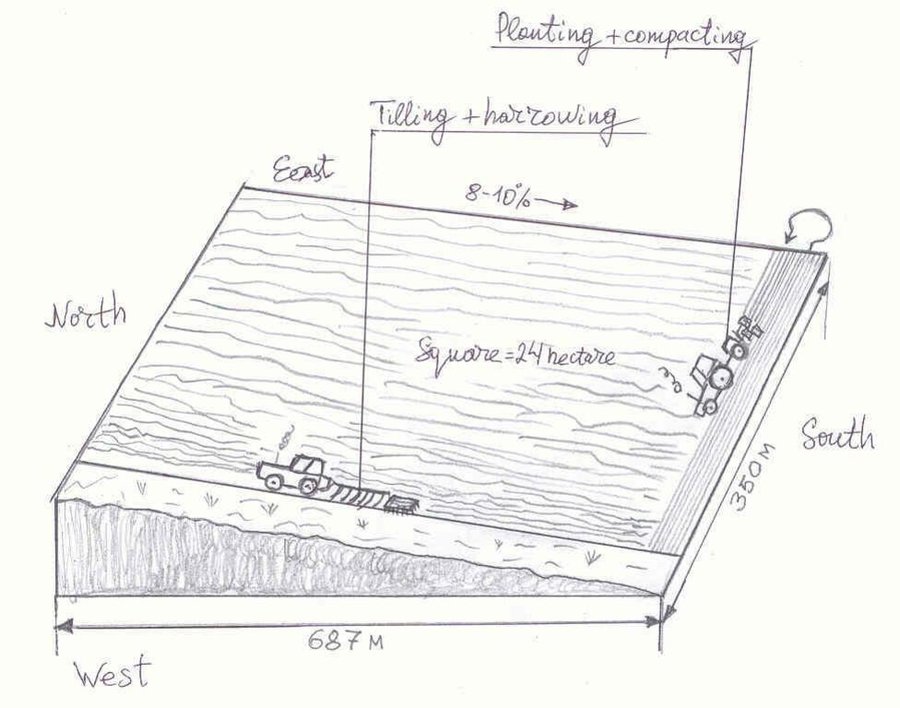
ຜູ້ຂຽນ: Azimjan Ibraimov, Suusamyr Village
Fields are located on South exposition of the foothills of the Kyrgyz Ala-Too Mountains in the Northern part of the Suusamyr valley. The length of the sainfoin field is 687 meters, and its width is 350 meters. Slope steepness is 8-10 %.
Tilling is conducted along the slope by a tractor K-700, with harrowing being conducted at the same time. The depth of tilling is 20-22 cm. Planting is conducted across to plowing direction. The date for sainfoin sowing is the first ten days of May. The seeds required are 80 kg/ha. Depth of sowing is 4 cm. This field is situated 8 kilometers from central Suusamyr village, reachable on a bad dirt road. Location: Suusamyr Valley. Jaiyl raion / Chui oblast / Kyrgyzstan Date: 11.01.2011 Technical knowledge required for field staff / advisors: high (Special training is requested) Technical knowledge required for land users: low (Field demonstration is needed) Main technical functions: control of dispersed runoff: impede / retard, stabilisation of soil (eg by tree roots against land slides), increase in organic matter, increase in nutrient availability (supply, recycling,…) Secondary technical functions: improvement of subsoil structure (hardpan) Vegetative measure: field planted by perennual grass Vegetative material: C : perennial crops Number of plants per (ha): 3000000 Spacing between rows / strips / blocks (m): 0.15 Width within rows / strips / blocks (m): 0.15 Vegetative measure: Vegetative material: C : perennial crops Perennial crops species: Sainfoin os sowed with planting machine C3-3.6. The distance between colters is 15 cm. |
|||||||||||
| ລະບຸ ປັດໃຈ ນໍາເຂົ້າ ໃນການຜະລີດ | ຫົວໜ່ວຍ | ປະລິມານ | ຕົ້ນທຶນ ຕໍ່ຫົວໜ່ວຍ (KGS) | ຕົ້ນທຶນທັງໝົດ ຂອງປັດໃຈຂາເຂົ້າ ໃນການຜະລິດ (KGS) | % ຂອງຕົ້ນທຶນທັງໝົດ ທີ່ຜູ້ນໍາໃຊ້ທີ່ດິນ ໃຊ້ຈ່າຍເອງ |
| ແຮງງານ | |||||
| establishment costs | hectare | 1.0 | 187.0 | 187.0 | |
| labour | person/hour | 0.8 | 128.0 | 102.4 | 100.0 |
| ວັດສະດຸໃນການປູກ | |||||
| seeds | hecatre | 1.0 | 108.0 | 108.0 | |
| seeds | kg | 75.0 | 2600.0 | 195000.0 | |
| ອື່ນໆ | |||||
| fuel | liter | 58.0 | 321.0 | 18618.0 | |
| ຕົ້ນທຶນທັງໝົດ ໃນການຈັດຕັ້ງປະຕິບັດ ເຕັກໂນໂລຢີ | 214'015.4 | ||||
ປະລິມານ ກ່ອນການຈັດຕັ້ງປະຕິບັດ ການຄຸ້ມຄອງ ທີ່ດິນແບບຍືນຍົງ: 19 c/ha
ປະລີມານ ຫຼັງການຈັດຕັ້ງປະຕິບັດ ການຄຸ້ມຄອງ ທີ່ດິນແບບຍືນຍົງ: 23 c/ha
ປະລິມານ ກ່ອນການຈັດຕັ້ງປະຕິບັດ ການຄຸ້ມຄອງ ທີ່ດິນແບບຍືນຍົງ: 500 bales
ປະລີມານ ຫຼັງການຈັດຕັ້ງປະຕິບັດ ການຄຸ້ມຄອງ ທີ່ດິນແບບຍືນຍົງ: 550 bales
ປະລິມານ ກ່ອນການຈັດຕັ້ງປະຕິບັດ ການຄຸ້ມຄອງ ທີ່ດິນແບບຍືນຍົງ: 0
ປະລີມານ ຫຼັງການຈັດຕັ້ງປະຕິບັດ ການຄຸ້ມຄອງ ທີ່ດິນແບບຍືນຍົງ: 24 ha
ປະລິມານ ກ່ອນການຈັດຕັ້ງປະຕິບັດ ການຄຸ້ມຄອງ ທີ່ດິນແບບຍືນຍົງ: 0
ປະລີມານ ຫຼັງການຈັດຕັ້ງປະຕິບັດ ການຄຸ້ມຄອງ ທີ່ດິນແບບຍືນຍົງ: 1
ປະລິມານ ກ່ອນການຈັດຕັ້ງປະຕິບັດ ການຄຸ້ມຄອງ ທີ່ດິນແບບຍືນຍົງ: 0
ປະລີມານ ຫຼັງການຈັດຕັ້ງປະຕິບັດ ການຄຸ້ມຄອງ ທີ່ດິນແບບຍືນຍົງ: 2 training
ປະລິມານ ກ່ອນການຈັດຕັ້ງປະຕິບັດ ການຄຸ້ມຄອງ ທີ່ດິນແບບຍືນຍົງ: 80%
ປະລີມານ ຫຼັງການຈັດຕັ້ງປະຕິບັດ ການຄຸ້ມຄອງ ທີ່ດິນແບບຍືນຍົງ: 95%
ປະລິມານ ກ່ອນການຈັດຕັ້ງປະຕິບັດ ການຄຸ້ມຄອງ ທີ່ດິນແບບຍືນຍົງ: None
ປະລີມານ ຫຼັງການຈັດຕັ້ງປະຕິບັດ ການຄຸ້ມຄອງ ທີ່ດິນແບບຍືນຍົງ: 5ha
Project recruts a security guard to protect sainfoin field since May. And at the same time he watches the neighbours fields.Therefore damage on it is reduced.